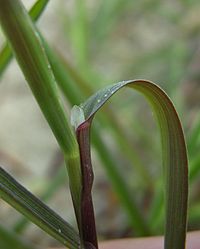
Fusarium patch is a disease in turf grass settings also called pink snow mold or Microdochium patch. In many cool season grass species in North America, it is caused by the fungus Microdochium nivale. The white-pink mycelium on infected leaf blades is a distinguishing characteristic of the Microdochium nivale pathogen. Fusarium patch is considered economically important in the turf grass industry because of its tendency to cause significant injury to golf greens, thereby decreasing putting surface quality. Dissimilar from other snow molds, such as gray snow mold, Microdochium nivale does not need snow cover to cause widespread infection.

Agrostis is a large and very nearly cosmopolitan genus of plants in the grass family, found in nearly all the countries in the world. It has been bred as a GMO creeping bent grass.
A transgene is a gene that has been transferred naturally, or by any of a number of genetic engineering techniques, from one organism to another. The introduction of a transgene, in a process known as transgenesis, has the potential to change the phenotype of an organism. Transgene describes a segment of DNA containing a gene sequence that has been isolated from one organism and is introduced into a different organism. This non-native segment of DNA may either retain the ability to produce RNA or protein in the transgenic organism or alter the normal function of the transgenic organism's genetic code. In general, the DNA is incorporated into the organism's germ line. For example, in higher vertebrates this can be accomplished by injecting the foreign DNA into the nucleus of a fertilized ovum. This technique is routinely used to introduce human disease genes or other genes of interest into strains of laboratory mice to study the function or pathology involved with that particular gene.

Poa annua, or annual meadow grass, is a widespread low-growing turfgrass in temperate climates. Notwithstanding the reference to annual plant in its name, perennial bio-types do exist. This grass originated as a hybrid between Poa supina and Poa infirma. Major chromosomal rearrangements after polyploidy have contributed to variation in genome size in Poa annua.
British NVC community MG11 is one of the mesotrophic grassland communities in the British National Vegetation Classification system. It is one of three types of mesotrophic grassland classified as grass-dominated inundation communities.
The Scotts Miracle-Gro Company is an American multinational corporation headquartered in Marysville, Ohio, where O.M. Scott began selling lawn seed in 1868. The company manufactures and sells consumer lawn, garden and pest control products, and soilless indoor gardening equipment. In the U.S., the company manufactures Scotts, Miracle-Gro and Ortho brands. The company on the other hand also markets consumer Roundup.

Genetic pollution is a term for uncontrolled gene flow into wild populations. It is defined as "the dispersal of contaminated altered genes from genetically engineered organisms to natural organisms, esp. by cross-pollination", but has come to be used in some broader ways. It is related to the population genetics concept of gene flow, and genetic rescue, which is genetic material intentionally introduced to increase the fitness of a population. It is called genetic pollution when it negatively impacts the fitness of a population, such as through outbreeding depression and the introduction of unwanted phenotypes which can lead to extinction.
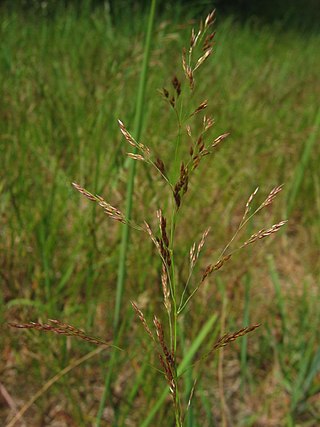
Agrostis capillaris, the common bent, colonial bent, or browntop, is a rhizomatous and stoloniferous perennial in the grass family (Poaceae). It is native to Eurasia and has been widely introduced in many parts of the world. Colonial bent grows in moist grasslands and open meadows, and can also be found in agricultural areas, roadsides, and invading disturbed areas.

Agrostis exarata is a species of grass known by the common names spike bentgrass, spike bent, Pacific bentgrass, and spike redtop. It is native to western North America from Texas to the Aleutian Islands.

Hordeum brachyantherum, known by the common name meadow barley, is a species of barley. It is native to western North America from Alaska to northern Mexico, coastal areas of easternmost Russia (Kamchatka), and a small area of coastal Newfoundland.

Agrostis microphylla is a species of grass known by the common name small-leaf bentgrass. It is native to western North America from the Aleutian Islands to Baja California in Mexico, where it grows along coastal cliffs, on serpentine mountain slopes, and in vernal pools.

Agrostis gigantea, known by its common names black bent and redtop, is a perennial grass of the Agrostis genus.
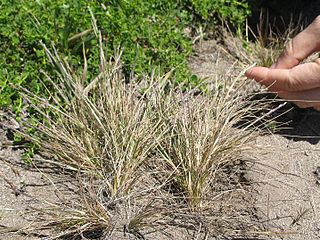
Agrostis blasdalei is a species of grass known by the common name Blasdale's bent grass. It is endemic to the coast of northern California, where it grows in habitat along the immediate coastline, such as dunes and bluffs.
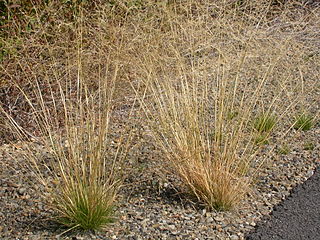
Agrostis scabra is a common species of grass known by the common names hair grass, rough bent, rough bent grass, winter bent grass, and ticklegrass. A tumbleweed, it is a bunchgrass native to Asia and much of North America, and widely known elsewhere as an introduced species.
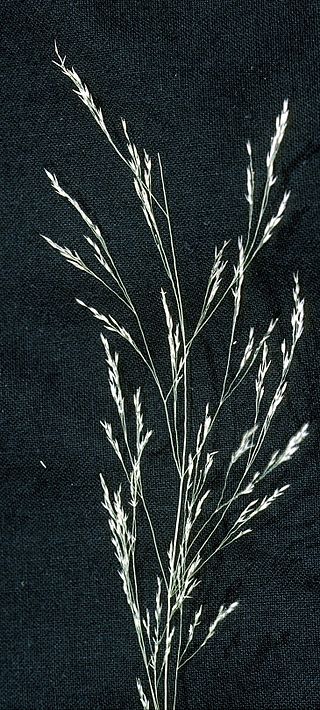
Agrostis perennans, the upland bentgrass, upland bent, or autumn bent, is a species of flowering plant in the grass family, Poaceae.
Herbicide safeners are organic compounds used to enhance the effectiveness of herbicides, to make them "safer". They minimize the effect of the herbicide on crop plants, thereby improving selectivity between crop plants vs. weed species being targeted by the herbicide. One way that they function is by enhancing the expression of protective enzymes in the crop plant. These protective enzymes might include cytochrome P450.

Salt pannes and pools are water retaining depressions located within salt and brackish marshes. Pools tend to retain water during the summer months between high tides, whereas pannes generally do not. Salt pannes generally start when a mat of organic debris is deposited upon existing vegetation, killing it. This creates a slight depression in the surrounding vegetation which retains water for varying periods of time. Upon successive cycles of inundation and evaporation the panne develops an increased salinity greater than that of the larger body of water. This increased salinity dictates the type of flora and fauna able to grow within the panne. Salt pools are also secondary formations, though the exact mechanism(s) of formation are not well understood; some have predicted they will increase in size and abundance in the future due to rising sea levels.

Agrostis canina, the velvety bentgrass, brown bent or velvet bent, is a species of grass in the family Poaceae.

Agrostis vinealis is a species of grass known by the common names brown bentgrass and brown bent, which can be found from Russia to Mongolia, China, Pakistan, India and Alaska. It was introduced to Greenland and South Georgia and the South Sandwich Islands.

Agrostis humilis is a species of grass known by the common names of mountain bent grass and alpine bentgrass, which can be found in Western United States and Canada.


